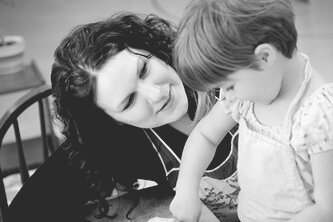
Peeling Back the Layers: the Montessori Presentation
— Maria Montessori, Creative Development in the Child, Volume IIWhen we bring something new into the child’s mind, we must dedicate exclusively to the child the few minutes needed to offer him these items in knowledge. No matter what happens around us, no matter what calls us, only one task must exist for the teacher at that moment, the imparting of the lesson to the child. The child knows that during these few minutes we exist for him alone and nobody else.
Your three-year-old child comes home and excitedly tells you she got a lesson on table-scrubbing today.
You may think many things: gratitude for your child’s obvious delight in receiving this one-on-one time with her classroom guide; or perhaps you ponder how to parlay this new skill into a home-based activity; or you may ask yourself, “I’m paying how much in tuition to have my kid doing housework?”
Whether a lesson on polishing brass or the Pythagorean theorem, any Montessori presentation has certain common characteristics.
Indirect Preparation (or, It’s Not Just About Scrubbing a Table)
Montessori identified indirect preparation as a natural phenomenon. For example, the embryo builds organs which will not be utilized until the future. Back to our example of table-scrubbing: there are many precursors that lead up to the child being able to execute this activity successfully, such as knowing where and how to fetch the items needed from the environment: a bucket of water, an apron, an underlay, the activity from the shelf, etc. There is of course the most obvious purpose of the activity: care of the environment. But there are so many other purposes for the lesson: support of sequential thinking; development of equilibrium; control and coordination of whole-body movement; fine motor development; providing a motive for concentration and repetition; and development of the will/self-control. And did you know that even the way in which the guide shows the child to use the brush to scrub the table (controlled, circular motions, left to right, top down) is laying track for reading and writing? Or that the tiny knobs on the Puzzle Maps are helping to prepare the hand for a beautiful three-point pencil grip later on, when it comes time for writing? Every single Montessori material and lesson has both direct and indirect purposes and extensions to keep a child engaged, interested, and challenged. These intellectual and physical antecedents prepare both the mind and body for the academic and developmental work to come.
Analysis of Movement
Every component of every activity in a Montessori environment is carefully broken down into individual steps, particularly the physical movements, with no detail too small for consideration. Great care is given when demonstrating an activity to use slow, deliberate movements to isolate each step in the sequence, using points of interest to draw the child’s attention to the particularly challenging steps of an activity. In this way, we make the task (such as learning to tie a bow, or performing multiplication with the bead frame) accessible to the child. Dr. Montessori said that the goal is to simultaneously provide a beautiful, accessible model of the activity while “destroying the possibility of imitation.” Once the child integrates and masters the activity, it becomes his and he can then do it successfully on his own, in his own way.
Control of Error
Ah, the Montessori lexicon. “Control of Error” does not mean we suppress or are dismayed by a child’s errors in a sequence—far from it. Learning best comes through trial and error, and we are nothing if not friendly with error here. What it really means in contemporary terms is “feedback”. The genius of the Montessori materials is that they give the child direct feedback from the materials themselves, instead of the adult being the arbiter of “correct” or “incorrect”. Sometimes the feedback is mechanical: for instance, a cylinder block’s graduated ten cylinders only fit in the block one way. The child sees that if he has a cylinder left over that doesn’t fit, he can remove the cylinders and try it again until they are all back in the block. Sometimes the feedback is perceptual: “Did I get the right sum in my addition problem?” The child knows she can fetch the addition control chart and check her answer for accuracy. And in the larger scheme of things, this promotes independence, both physical and psychological: “I can do it by myself, for myself.”
The Individual or Small-Group Lesson
Some refer to the Montessori teacher as “the guide on the side” versus “the sage on the stage”. The guide provides individual or small-group lessons to children throughout each day based upon their knowledge of each child, their developmental characteristics and needs, and the observed interests and activity of each student, versus the large-group instruction more common in conventional educational models. In this way, the guide is able to provide what each child needs, when they need it. Not only that, the curriculum is dynamic enough to allow for a great deal of individualization for each child in order to support his or her success.
— Maria Montessori, The Absorbent Mind“The essential thing is for the task to be so inviting that it arouses the child’s whole personality.”
For those interested in more key terms in the Montessori lexicon, the Association Montessori Internationale/USA has created a helpful Montessori dictionary.
